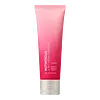What's inside
What's inside
 Key Ingredients
Key Ingredients

No key ingredients
 Benefits
Benefits

 Concerns
Concerns

 Ingredients Side-by-side
Ingredients Side-by-side

Water
Skin ConditioningGlycerin
HumectantLauryl Glucoside
CleansingSodium Lauroyl Sarcosinate
CleansingCocamidopropyl Betaine
CleansingDiglycerin
HumectantBetaine
HumectantAcetamidoethoxyethanol
HumectantPEG-7 Glyceryl Cocoate
EmulsifyingMyristic Acid
CleansingAcrylates/Beheneth-25 Methacrylate Copolymer
Sodium Cocoyl Isethionate
CleansingGlycol Distearate
EmollientTriethylene Glycol
MaskingButylene Glycol
HumectantPolyglutamic Acid
Skin ConditioningPhenoxyethanol
PreservativeDisodium EDTA
O-Cymen-5-Ol
AntimicrobialWater, Glycerin, Lauryl Glucoside, Sodium Lauroyl Sarcosinate, Cocamidopropyl Betaine, Diglycerin, Betaine, Acetamidoethoxyethanol, PEG-7 Glyceryl Cocoate, Myristic Acid, Acrylates/Beheneth-25 Methacrylate Copolymer, Sodium Cocoyl Isethionate, Glycol Distearate, Triethylene Glycol, Butylene Glycol, Polyglutamic Acid, Phenoxyethanol, Disodium EDTA, O-Cymen-5-Ol
Water
Skin ConditioningMyristic Acid
CleansingGlycerin
HumectantBehenic Acid
CleansingPalmitic Acid
EmollientPotassium Hydroxide
BufferingSodium Methyl Cocoyl Taurate
CleansingLauric Acid
CleansingStearic Acid
CleansingMontmorillonite
AbsorbentLaminaria Saccharina Extract
Skin ProtectingPorphyridium Cruentum Extract
Skin ConditioningLactobacillus Ferment
Skin ConditioningNiacinamide
SmoothingHydrolyzed Rice Extract
Skin ConditioningPunica Granatum Extract
AstringentZinc PCA
HumectantDipotassium Glycyrrhizate
HumectantCamellia Sinensis Leaf Extract
AntimicrobialSodium Hyaluronate
HumectantCucumis Sativus Fruit Extract
EmollientSodium Phytate
Potassium Sorbate
PreservativeGlycol Distearate
EmollientButylene Glycol
HumectantDisodium EDTA
Sodium Benzoate
MaskingPolyquaternium-7
Phenoxyethanol
PreservativeWater, Myristic Acid, Glycerin, Behenic Acid, Palmitic Acid, Potassium Hydroxide, Sodium Methyl Cocoyl Taurate, Lauric Acid, Stearic Acid, Montmorillonite, Laminaria Saccharina Extract, Porphyridium Cruentum Extract, Lactobacillus Ferment, Niacinamide, Hydrolyzed Rice Extract, Punica Granatum Extract, Zinc PCA, Dipotassium Glycyrrhizate, Camellia Sinensis Leaf Extract, Sodium Hyaluronate, Cucumis Sativus Fruit Extract, Sodium Phytate, Potassium Sorbate, Glycol Distearate, Butylene Glycol, Disodium EDTA, Sodium Benzoate, Polyquaternium-7, Phenoxyethanol
Ingredients Explained
These ingredients are found in both products.
Ingredients higher up in an ingredient list are typically present in a larger amount.
Butylene Glycol (or BG) is used within cosmetic products for a few different reasons:
Overall, Butylene Glycol is a safe and well-rounded ingredient that works well with other ingredients.
Though this ingredient works well with most skin types, some people with sensitive skin may experience a reaction such as allergic rashes, closed comedones, or itchiness.
Learn more about Butylene GlycolDisodium EDTA plays a role in making products more stable by aiding other preservatives.
It is a chelating agent, meaning it neutralizes metal ions that may be found in a product.
Disodium EDTA is a salt of edetic acid and is found to be safe in cosmetic ingredients.
Learn more about Disodium EDTAGlycerin is already naturally found in your skin. It helps moisturize and protect your skin.
A study from 2016 found glycerin to be more effective as a humectant than AHAs and hyaluronic acid.
As a humectant, it helps the skin stay hydrated by pulling moisture to your skin. The low molecular weight of glycerin allows it to pull moisture into the deeper layers of your skin.
Hydrated skin improves your skin barrier; Your skin barrier helps protect against irritants and bacteria.
Glycerin has also been found to have antimicrobial and antiviral properties. Due to these properties, glycerin is often used in wound and burn treatments.
In cosmetics, glycerin is usually derived from plants such as soybean or palm. However, it can also be sourced from animals, such as tallow or animal fat.
This ingredient is organic, colorless, odorless, and non-toxic.
Glycerin is the name for this ingredient in American English. British English uses Glycerol/Glycerine.
Learn more about GlycerinGlycol Distearate serves as a pearlizing or opacifying agent in cosmetic products.
It's often included in cleansers and haircare products to give them a lustrous or shimmering appearance.
It is derived from stearic acid, a natural fatty acid commonly found in vegetable oils and animal fats.
Glycol Distearate isn't fungal acne safe.
Learn more about Glycol DistearateMyristic Acid is a saturated fatty acid. It is naturally found in milk fat. Other sources include palm oil, coconut oil, and butter fat.
Myristic Acid is an emulsifer and cleanser. As an emulsifer, it stabilizes a product by preventing ingredients from separating. Myristic Acid helps clean your skin by acting as a surfactant. It tends to gather oil and dirt on your skin to be easily rinsed away.
One study from 2021 found Myristic Acid to have anti-inflammatory properties.
Learn more about Myristic AcidPhenoxyethanol is a preservative that has germicide, antimicrobial, and aromatic properties. Studies show that phenoxyethanol can prevent microbial growth. By itself, it has a scent that is similar to that of a rose.
It's often used in formulations along with Caprylyl Glycol to preserve the shelf life of products.
Water. It's the most common cosmetic ingredient of all. You'll usually see it at the top of ingredient lists, meaning that it makes up the largest part of the product.
So why is it so popular? Water most often acts as a solvent - this means that it helps dissolve other ingredients into the formulation.
You'll also recognize water as that liquid we all need to stay alive. If you see this, drink a glass of water. Stay hydrated!
Learn more about Water